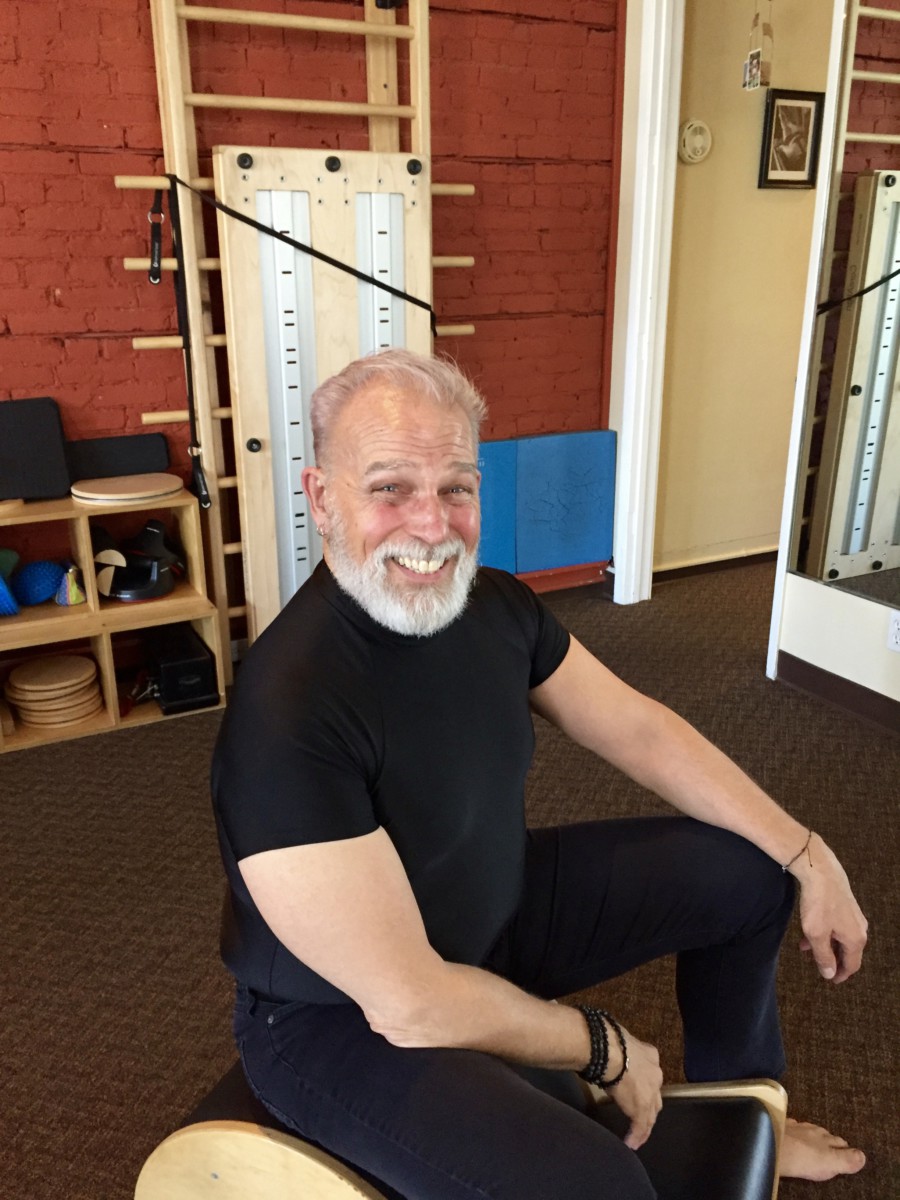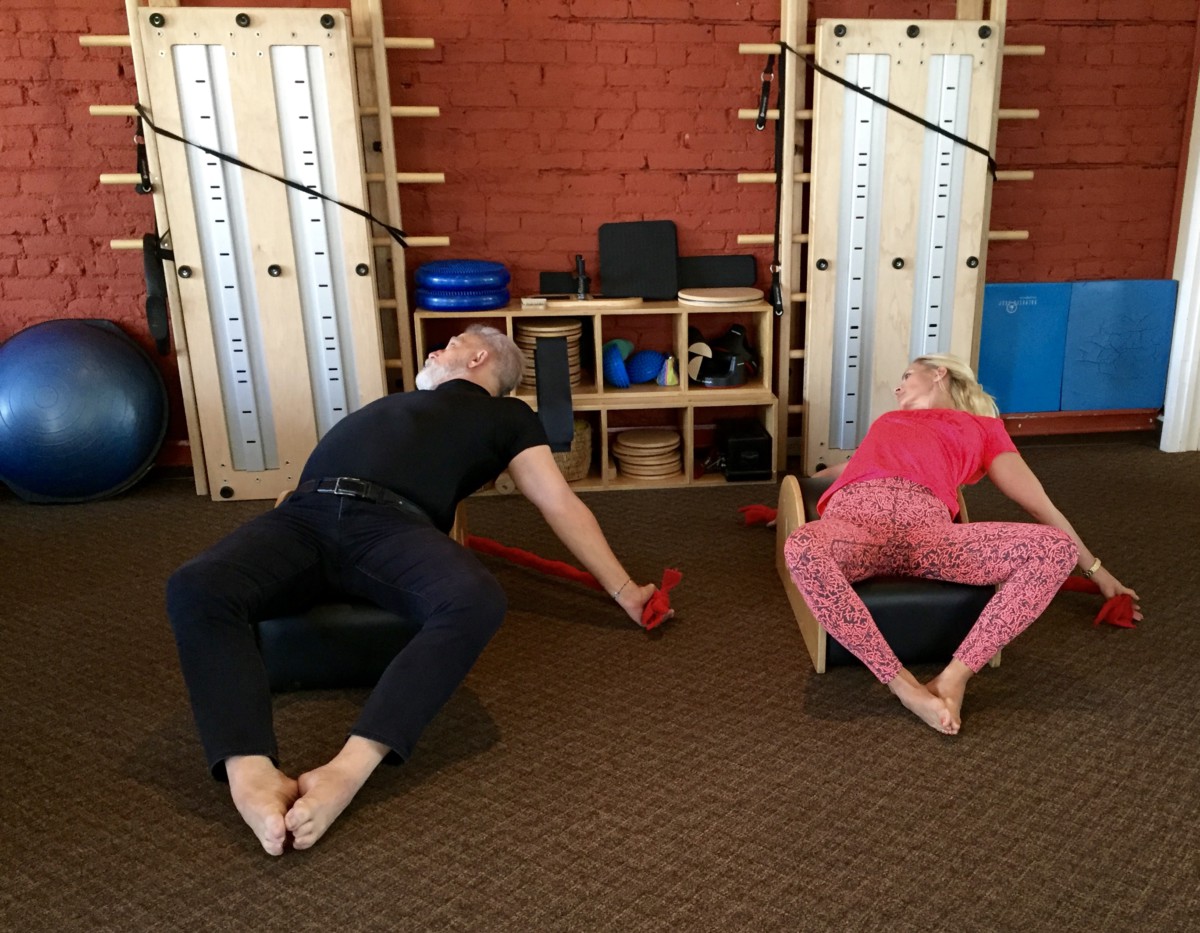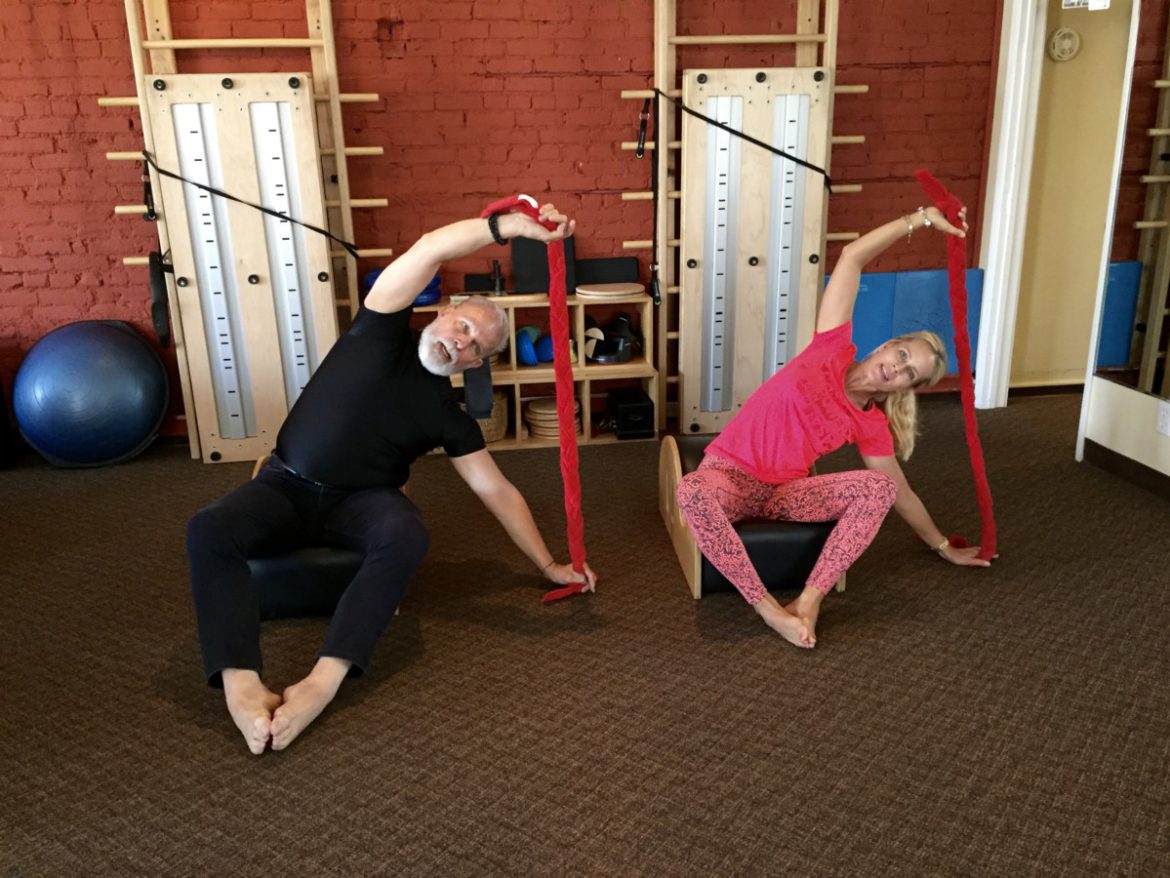This post is also available in: Norsk (Norwegian )
I met Ken Gilbert. He is an experienced pilatesinstructor, in fact second generation and his teacher was Ron Fletcher. He is one of the Pilates Anytime instructors which might be the biggest online Pilates workout Centre. And – my great inspiration before I launched my own online centre together with Rikke Schillinger. The recent years there have been many interpretations of workouts inspired by the Pilates Method. Something borrowed, something new, and with lots of variations from the world of pilates. This is quite normal in the business of bodywork and hybrids occurs. With this in mind it´s especially great to meet teachers with such unique knowledge of pilates like the one Ken Gilbert has.
 I feel humble and quit “young” in this world of Pilates and it gives me a real kick. There afre always new stuff to learn, explore and practice. New understandings of the body and mind connections. Sometimes I even have to close my eyes in order to deeply feel what I am actually doing!
I feel humble and quit “young” in this world of Pilates and it gives me a real kick. There afre always new stuff to learn, explore and practice. New understandings of the body and mind connections. Sometimes I even have to close my eyes in order to deeply feel what I am actually doing!

Ken Gilbert med sitt herlige smil, men sylskarpe blikk!
The last months I have joined Ken´s “Spine Corrector” class. The class is not fancy, there is no cardio to it, but its amazing to use this apparatus. Because while sitting on the lip or in the crevice of the corrector we are able to stimulate spine movements that are supported, we learn through feed-back from surfaces of the corrector we than can learn how to accomplish movement of the spine when the corrector is not available.

Fra venstre Leslie Leddo, Chris Brandeland, Ken Gilbert, Carole Thompson og meg
After the class Ken is doing a reminder. With the feet in a “turn-out” position we reach our hands into a “Namaste” towards the sky, then to the head, to the heart and down towards the legs. this is a beautiful reminder of being in the universe, in our minds, in our emotions and in our bodies. Just the way I think a Pilates class should be performed.
I hope you will enjoy our conversation under.

Apparatet heter “Spine Corrector”
Tell me about your background and how you trained the Pilates method?
I began my Pilates learning and practice in 1994 when I realized that my physical “vocabulary” was limited to fitness activities that I had begun in 1987 through high-low impact, step, spin, etc. I longed for a deeper and better connection to my body/brain integration and I had returned to theatre where I was producing, directing and performing. I wanted a stronger and more expressive body through movement and emotion. I trained with several “traditional” Pilates teachers and found Ron Fletcher in 1996 who became my mentor of the work. In 2007 I made a major shift in my Pilates Teacher profile by leaving Santa Barbara Athletic Club (after 13 years of my training, teaching and installing the Pilates Program in Group Fitness) and departing from The Ron Fletcher Work Program. I went out on my own as EMBODYMENT . I have been a Nia Teacher since 1999 and a Nia Trainer from 2005 – 2016. I integrate my body awareness and mindfulness into a way of teaching both programs that is unique.
How do you think pilates is changing – and what should we look for in order to find the best workouts?
There are many interpretations of Pilates. In my work with Ron Fletcher I learned to see the work through his eyes; seeking detail and expressivity of each movement. Through his guidance I learned a movement pattern then he would say: “Now, show it to me . . .” meaning that he was expecting the full breath (percussive breathing) with full extension and movement from the core into the extremities; nothing was ever unfinished.
What is in your opion the difference between a pilates teacher and an instructor?
- I have a philosophy – there are three stages of being a teacher/educator:
- Instructor instructs the student to do the movement: “This is what you do . . .”
- Teacher teaches the student how to personalize the movement: “This is how you do what you are doing in the most efficient way . . .”
- Educator educates the the student in how the movement will enhance their body and their life: “In this movement you become aware, conscious and mindful of your body in every moment.
What does it mean to live in a healthy spine, and is this accessable for everyone?
Everybody is entitled to a healthy spine; one that is capable of stability and mobility in any moment. There are 5 Primary joint actions of the spine that must be maintained on a daily basis; the spine requires forward flexion, lateral flexion, extension, rotation and circumduction. With body awareness as the guide, anybody can activate the nervous system through the intervertebral articulation that is appropriate for their individual spine. Each of us will have special concerns that become our individual journey into a healthy nervous system (centralized through the spine).
Many people seem to live outside of ther body and more from the head, how can body awareness help to live more in And with yourself?
Living life without distraction is the healthy choice. Living in a body means that we give time to placing our attention on body awareness – physical sensations and emotional responses. Consciousness comes from placing our attention on the mental (ideas and thoughts) and spirit (unique life force) realms. In order to live in the balance of body|mind|emotion|spirit we must become masters of where we place our attention. The body lives in the present moment. If we learn to keep our attention on our body’s experiences whilst spending time with our emotions, ideas, thoughts, and into our expanded energies, we will live with more connection to our systemic selves and with others in the world.
In what way does pilates (body contrology) becomes also meditation?
This is an interesting question of what Pilates is and can become. Many people do not know that Joseph H. Pilates taught what he called “Body Contrology” – the study of body control; current culture calls the work “Pilates”. When we place our attention on the present moment whilst moving, when we move without the distractions of thinking about the movement or how we feel about what we are doing, when we breathe and move with purpose to the brain|body connection we are in a moving meditation.
You have designed a ”spine corrector class” – what kind of class is that?
Spine Corrector Class is a specialty class using the apparatus of the “Spine Corrector” – a small piece of furniture that is shaped like a coma or quotation mark. Sitting or laying on the arc, the lip or in the crevice of the corrector we are able to stimulate spine movements that are supported. My personal philosophy about working with the apparatus is simple; when we learn through feed-back from surfaces of the corrector we than can learn how to accomplish movement of the spine when the corrector is not available. The 55 minute class is intended to develop an individual’s ability to stabilize and mobilize the spine through the 5 Primary joint actions of which the healthy spine is capable.
How will the spine corecctor make us work deeper?
We work deeper when we feel supported (without collapsing); we are able to find more “lift” rather than compression of the vertebrae and the discs. Sitting on the lip we sense the Sitz Bones. Sitting on the arc we sense an upright spine in a familiar sitting position. Sitting in the crevice allows us to sense the lower back supported during flexion and extension of the spine.
We also use the pilates towel – what is the purpose?
The Red Towel comes from my study in The Ron Fletcher Work (now known as Fletcher Pilates). It is a tool used to define the sensibility of dynamic stabilization; by holding the towel taut the shoulder girdle is stabilized. When held loosely, the towel becomes a tool of expressivity (an extension of the arms) creating systemic movement through out the body.

Sidefleksjon med håndkle
Some good workout virtous to keep in mind?
Stay focused at all times to move from isolation to integration. Take time to sense and feel the body’s movements. When something does not feel “right” slow down or stop and assess a more efficient range of motion or movement direction. The body is always telling the truth and movement is its language.

If you want to learn more about Ken Gilbert you can check out his blog here:
Follow Ken on Facebook:
Ken Gilbert EMBODYMENT
And soon you can workout with him at www.webtrening.no also!!!!
Best wishes,
Monica
Clothes by @casalltraining

